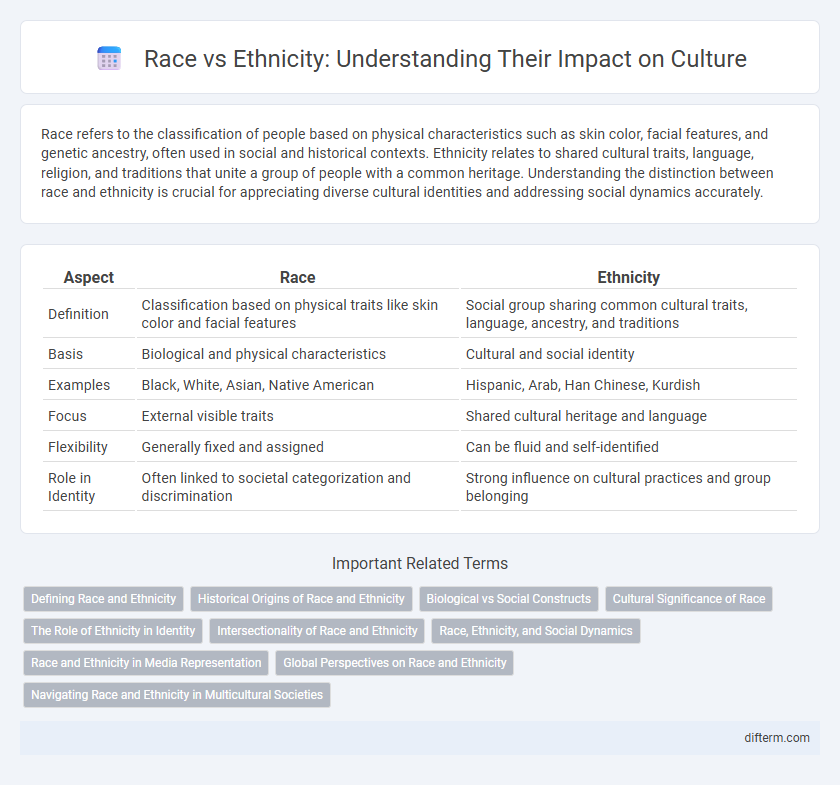Race refers to the classification of people based on physical characteristics such as skin color, facial features, and genetic ancestry, often used in social and historical contexts. Ethnicity relates to shared cultural traits, language, religion, and traditions that unite a group of people with a common heritage. Understanding the distinction between race and ethnicity is crucial for appreciating diverse cultural identities and addressing social dynamics accurately.
Table of Comparison
| Aspect | Race | Ethnicity |
|---|---|---|
| Definition | Classification based on physical traits like skin color and facial features | Social group sharing common cultural traits, language, ancestry, and traditions |
| Basis | Biological and physical characteristics | Cultural and social identity |
| Examples | Black, White, Asian, Native American | Hispanic, Arab, Han Chinese, Kurdish |
| Focus | External visible traits | Shared cultural heritage and language |
| Flexibility | Generally fixed and assigned | Can be fluid and self-identified |
| Role in Identity | Often linked to societal categorization and discrimination | Strong influence on cultural practices and group belonging |
Defining Race and Ethnicity
Race refers to the classification of people based on physical characteristics such as skin color, facial features, and hair texture, often linked to biological traits. Ethnicity encompasses shared cultural traits, language, religion, and ancestral heritage that create a sense of belonging within a group. Understanding the distinction between race and ethnicity is essential for analyzing social identity and cultural diversity in society.
Historical Origins of Race and Ethnicity
Race originated as a social construct rooted in historical attempts to categorize humans based on physical characteristics, often linked to colonialism and imperialism. Ethnicity refers to shared cultural traits, language, and heritage that bind groups, with origins tracing back to ancestral societies and kinship networks. Historical distinctions between race and ethnicity highlight the impact of power dynamics and migration patterns on identity formation.
Biological vs Social Constructs
Race is often mistakenly viewed as a strictly biological classification based on physical traits like skin color and genetic markers, but scientific consensus shows these differences do not delineate distinct subspecies. Ethnicity, in contrast, is a social construct that encompasses shared cultural practices, language, religion, and historical experiences, shaping group identity beyond biological factors. Understanding race as a social construct challenges biological determinism and highlights the role of societal structures in shaping perceptions of identity.
Cultural Significance of Race
Race serves as a social construct deeply embedded in cultural identity, shaping shared experiences, traditions, and social dynamics within communities. It influences perceptions, group solidarity, and access to resources, often intersecting with historical narratives and power structures. Understanding the cultural significance of race reveals how societal beliefs and systemic inequalities are perpetuated, impacting individual and collective identities.
The Role of Ethnicity in Identity
Ethnicity plays a crucial role in shaping individual identity by connecting people through shared cultural traditions, language, and ancestral heritage. Unlike race, which categorizes individuals based on physical characteristics, ethnicity encompasses the social practices and collective history that foster a sense of belonging within a community. This cultural dimension of identity influences personal values, social interactions, and a deeper understanding of one's place in the world.
Intersectionality of Race and Ethnicity
Race and ethnicity intersect to shape individual identities and social experiences, influencing how people perceive themselves and are perceived by others. This intersectionality highlights the complexity of cultural belonging, as racial categories often emphasize physical characteristics, while ethnicity encompasses shared cultural practices, languages, and historical backgrounds. Understanding the interplay between race and ethnicity reveals nuanced layers of privilege, discrimination, and community connection within diverse societies.
Race, Ethnicity, and Social Dynamics
Race shapes social dynamics by categorizing individuals based on physical characteristics, influencing identity, power relations, and societal treatment. Ethnicity reflects cultural heritage, language, and shared traditions, often intersecting with race but emphasizing cultural bonds over biological traits. Understanding race and ethnicity clarifies social structures and highlights systemic inequalities within diverse communities.
Race and Ethnicity in Media Representation
Media representation plays a crucial role in shaping public perceptions of race and ethnicity, often reinforcing stereotypes or promoting inclusivity. Accurate and diverse portrayals of racial and ethnic groups in television, film, and advertising help challenge misconceptions and foster cross-cultural understanding. Increasingly, media outlets are prioritizing authentic storytelling to reflect the complexities of identity beyond superficial traits.
Global Perspectives on Race and Ethnicity
Race is generally understood as a social construct based on physical characteristics such as skin color, while ethnicity refers to shared cultural traits, language, and heritage. Global perspectives reveal that racial categories vary significantly across societies, often influenced by historical, political, and social contexts, whereas ethnicity encompasses more fluid and multifaceted identities tied to community and tradition. Understanding these distinctions is vital for addressing issues of identity, discrimination, and social cohesion in multicultural societies worldwide.
Navigating Race and Ethnicity in Multicultural Societies
Navigating race and ethnicity in multicultural societies requires understanding that race is often linked to physical characteristics, while ethnicity relates to shared cultural heritage and traditions. Recognizing these distinctions helps promote social cohesion by respecting diverse identities and reducing stereotypes. Effective policies and community initiatives that embrace both concepts support inclusivity and intercultural dialogue.
race vs ethnicity Infographic

 difterm.com
difterm.com